Tyrrell-Ford P34
Car: Tyrrell-Ford P34/ Engine: V-8 Ford-Cosworth DFV / Maker: Tyrrell / Bore X Stroke: 85.7 mm X 64.8 mm / Year: 1976 / Capacity: 2,993 cc / Class: Formula 1 / Power: 485 bhp at 10,600 rpm / Wheelbase: 96.6 inches / Track: 48.6 inches Front, 58 inches Rear / Weight: 1311.8 lbs
When “uncle” Ken Tyrrell rings you up and says : “Can you come over, I’ve got something to show you”, you don’t ask: “What?” or “Why?”. One thing about Ken, and I have known him for 40 years, is he never called a spade shovel; you know exactly where you stand with him, right or wrong. So one morning in September 1975, having just got back from Monza, I got on my motorcycle and rode over to Ken’s house in West Clandon, and after a welcoming cup of coffee he said: “Come out into the garden”. Totally unprepared for what to expect, I followed him out to the lawn and my mouth fell open, and a look of total disbelief came upon my face. Ken roared with laughter as I stood there speechless, and to this day he still has a chuckle at the memory of “Jenks speechless”. Denis Jenkinson describing the first time he laid eyes on the Tyrrell P34.
To overcome the lack of advantage inherent in a sport where most competitors were using the same engine (then the Ford Cosworth V-8 DFV), same gearbox and same (sole-supplier) Goodyear tires. Derek Gardiner sought to think outside of the box and Project 34 was begun with keen support from Ken Tyrrell, team owner.
It’s most striking feature of course was the use of four 10 in. wheels instead of the regular two. The front-end layout was intended to “… minimize induced drag by reducing lift at the front and to turn that gain into the ability to enter and leave corners faster”. The use of four small disc brakes required a special triple master-cylinder system, each feeding the brakes on one of the three axles. This was necessary as adjustments were required to control locking at the four front wheels.
If the two front wheels locked first, then the effective wheelbase of the car was shortened and if the second set of front wheels locked first this resulted in the effective wheelbase being lengthened. The size of the front tires put special stress on the cross-ply tires Goodyear supplied. Had radial-ply Michelin tires been available to the team the story might have been different. Unfortunatly Goodyear’s tire development program did not have the capacity to properly support the special 10 in. tires used by the P34.
The high point for what was known as Project 34 came at the Swedish Grand Prix in 1976 where Jody Scheckter came in first followed by his teammate Depailler in second. Gardner walked away from F1 midway through the 1977 season to become a director of Borg-Warner’s research division. After two seasons and the departure of Derek Gardner the experiment was abandoned.

















